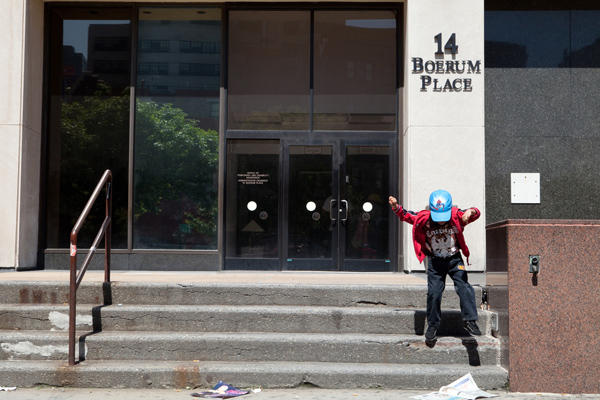
Photo by: Marc Fader
Public benefits recipients who wish to challenge a decision by the city’s social services agency go to the fair hearing site at 14 Boerum Place. Some 351,000 New Yorkers were on welfare in July, up 1 percent over the previous year. At earlier times in the economic crisis, the lack of any increase in welfare receipt raised questions about whether eligible people were being denied benefits.
According to data from the Census Bureau’s American Community Survey released Thursday, the poverty rate for New York City increased from 20.1 percent in 2010 to 20.9 percent in 2011.
That means 1,695,000 New Yorkers lived in households with incomes below the federal poverty threshold, which was $22,350 for a family of four.
It also means, for the city’s homeless shelters, more residents. The average daily population in the shelter system in August was 44,328—a number that has risen for five straight months and is 19 percent higher than in August 2011.
According to the Department of Homeless Services, the increase in shelter population reflects a combination of new entrants arriving in larger numbers and incumbent residents staying longer because the city no longer has its transitional housing program, Work Advantage, which helped people leave shelters.
Some 351,000 New Yorkers were on welfare in July, up 1 percent over the previous year. At earlier times in the economic crisis, the lack of any increase in welfare receipt raised questions about whether eligible people were being denied benefits. The number of people receiving cash assistance is very volatile: It rose last March, declined in April, crept up in May, then fell in June.
Also in July, more than 1.8 million people in the city received food stamps—the highest level in at least four and a half years. Since July 2008, the number of people receiving food stamps in New York has climbed by 45 percent, or as many people as live in Oklahoma City.
Only Manhattan saw a statistically significant increase in the poverty rate, which rose from 16. 4 percent in 2010 to 18.3 percent last year. In the other boroughs, poverty rates held steady at 30.4 percent in the Bronx, 23.6 percent in Brooklyn, 15.8 percent in Queens and 11.7 percent in Staten Island. About three in 10 Latinos and a quarter of black New Yorkers were poor, compared to 15.8 percent of whites and 19.6 percent of Asians.
One has to be careful reading poverty numbers, because the way the government measures poverty is flawed. The feds look at how much a family needs to spend on a basic diet, and then calculates a minimum subsistence income based on the assumption that a family spends about a third of its money on food.
First developed in the early 1960s, the method is outdated (families don’t spend a third of their income on food anymore), imprecise (the cost of living is much higher in some places than others) and incomplete (it ignores in-kind benefits that many low-income families receive).
New York City’s Center for Economic Opportunity has pioneered alternative measures of poverty that correct for these flaws. In recent years that number has moved in the same direction as the official poverty rate, and been higher: In 2010, the federal poverty measure was 18.8 percent, and the alternative statistic was 21 percent.







